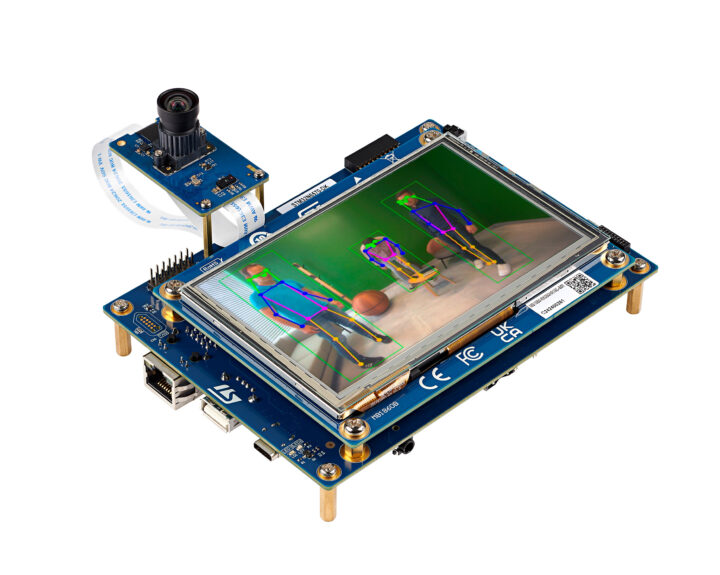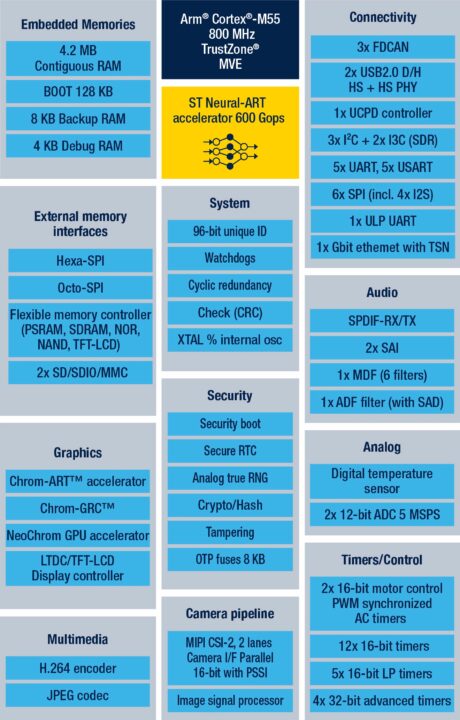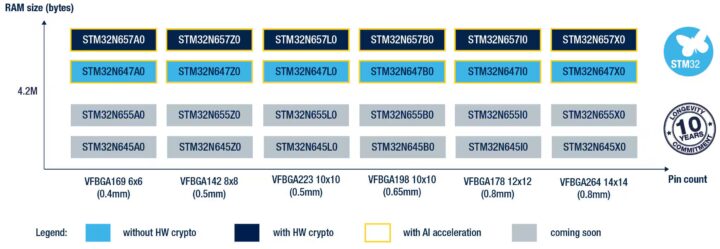STMicro has announced the availability of the STM32N6 microcontroller series based on the 800MHz ARM Cortex-M55 and the 600 GOPS-capable Neural-ART Accelerator.
The STM32N6 is the company’s “newest and most powerful STM32 series,” bringing MPU-level performance to MCUs. It is the first STM32 to feature the Arm Cortex-M55 and offer up to 4.2MB of embedded RAM. Additionally, the chip includes ST’s NeoChrom GPU and an H.264 hardware encoder.
According to Remi El-Quazzane, MDRF (Microcontrollers, Digital ICs, and RF Products) President at STMicro, the STM32N6 “marks the beginning of a long journey of AI hardware-accelerated STM32, which will enable innovations in applications and products in ways not possible with any other embedded processing solution.”
STMicro offers two versions of the STM32N6 MCU: the STM32N6x7 AI line featuring the Neural-ART accelerator and the STM32N6x5 GP (general-purpose) product line without an NPU. The microcontroller series is primarily targeted at computer vision and audio processing use cases in smart industry, smart home, automotive, personal electronics, medical, and healthcare.
Although the STM32N6 microcontroller is the first to offer a custom NPU, we have seen other Cortex-M55-powered MCUs such as the Ambiq Apollo510 and Infineon’s PSoC Edge series.
STM32N6 specifications:
- Core – Arm 32-bit Cortex-M55 CPU @ up to 800MHz with Arm Helium and Arm MVE
- GPU – Neo-Chrom 2.5D GPU, Chrom-ART Accelerator (DMA2D)
- NPU – ST Neural-ART Accelerator @ 1 GHz, 600 GOPS
- Memory/Storage
- “Flash-less” configuration
- 4.2MB contiguous SRAM
- Flexible memory controller (PSRAM, SDRAM, NOR, NAND)
- External memory interfaces (hexa-SPI, Octo SPI, FMC)
- Display and Video
- LCD-TFT controller up to XGA resolution
- Parallel and 2-lane CSI-2 camera interfaces
- Dedicated image signal processor (ISP)
- Dimensioned for 5-megapixel camera @ 30 fps
- Three parallel pipes on the same input stream
- H.264 encoder: 720p/1080p @ 30 fps
- Hardware JPEG codec with MJPEG
- Audio – 2x SAI, with four DMIC support
- Peripheral interfaces
- Up to 165 GPIO pins
- 2x USB 2.0 FS device/host OTG controllers (one with UCPD USB Type-C Power Delivery)
- 10Mbit, 100Mbit, and 1Gbit Ethernet with TSN (time-sensitive networking)
- 4x I2C Fm+ interfaces (SMBus/PMBus)+ 2x I3C
- 6x SPI; four I2S-capable
- 2x SDMMC
- 3x FDCAN with TTCAN capability
- 5x USART, 5x UART (ISO78916 interface, LIN, IrDA, up to 12.5 Mbit/s) + 1x LPUART
- Analog
- 1x temperature sensor
- 2x ADCs with 12-bit maximum resolution (up to 5 Msps), up to 20 channels
- 1x ADF filter with SAD and 1x MDF (six filters)
- Timers
- 1x high-resolution timer
- 4x 32-bit timers with up to four IC/OC/PWM or pulse counters and quadrature encoder input (up to 240 MHz)
- 2x 16-bit advanced motor control timers (up to 240 MHz)
- 13x 16-bit general-purpose and 5x 16-bit low-power timers (up to 240 MHz)
- 2x watchdogs (independent and window)
- 1x SysTick timer
- RTC with subsecond accuracy and hardware calendar
- Debugging – Serial wire debug (SWD), JTAG, Embedded Trace Macrocell (ETM)
- CRC calculation unit
- Clock management
- Internal oscillators: 64 MHz HSI, 4 MHz MSI, 32 kHz LSI
- External oscillators: 16 to 48 MHz HSE, 32.768 kHz LSE
- 4x PLL (one for the system clock, one for the ST Neural-ART Accelerator, two for kernel clocks) with fractional mode
- Reset and power management
- 1.71 V to 3.6 V application supply and I/Os
- Dedicated power for USB and XSPI I/Os
- Power-on/Power-down reset (POR/PDR), Programmable Brown-Out reset (BOR), Programmable Brownout Voltage Detection (PBVD)
- Low-power modes: Sleep, Stop, Standby, Shutdown
- VBAT supply for RTC, 32x 32-bit backup registers + 8-Kbyte backup SRAM
- SMPS power-down converter
- Packages
- VFBGA264 (14 x 14 mm)
- VFBGA223 (10 x 10 mm)
- VFBGA198 (10 x 10 mm)
- VFBGA178 (12 x 12 mm)
- VFBGA169 (6 x 6 mm)
- VFBGA142 (8 x 8 mm)
- Temperature Ranges – -40°C to 125°C
STMicro offers a “comprehensive ecosystem of software tools” to facilitate the development of edge AI applications with the STM32N6. The ST Edge AI suite bundles free software tools, examples, and documentation for developers of varying skill levels. The suite also includes the Edge AI Developer Cloud with dedicated neural networks from the STM32 model zoo as well as a board farm for benchmarking. ST also promises that existing frameworks can be used with the STM32N6 series via the ST Edge AI-Core which enables optimizing and compiling neural networks to work with ST hardware.

Both versions of the STM32N6 MCU series are offered in 142- to 264-pin VFBGA packages and are now available for “high-volume” buyers. There are two evaluation boards currently available for the series, the $185 STM32N6570-DK Discovery Kit and the $56.25 Nucleo-144 board. More information is available on the product page.
Thanks to TLS for the tip.

Tomisin is a writer specializing in hardware product reviews, comparisons, and explainers. He is very passionate about small form factor and single-board computers.
Support CNX Software! Donate via cryptocurrencies, become a Patron on Patreon, or purchase goods on Amazon or Aliexpress






